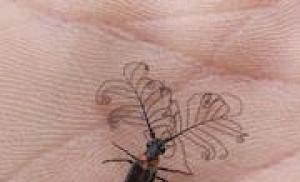Alyssum varieties and types. Alyssum - "Unpretentious Lobularia": planting and leaving Alyssum silvery
Among the low-growing flowering plants, it is worth highlighting alyssum - compact lush bushes up to 40 cm high, which branch strongly. It belongs to the cruciferous family and is often used as a groundcover. Growing rapidly and releasing their long semi-lignified shoots in different directions, the bushes form a beautiful carpet of small long leaves and small flowers. Alyssum blooms throughout the spring, spreading a delicate aroma around. The color of inflorescences in the form of panicles can be very diverse: from pale white to deep purple.
Today there are about 200 plant species, among them there are both annual crops that require annual planting and renewal, and perennial varieties that can live in open ground for several years. All of them are quite unpretentious and do not need special care. But depending on whether it is a perennial or an annual, some differences in their cultivation still exist, and they are worth paying attention to.
Long-flowering annual alyssum
Annual plant species are distinguished by a longer flowering period, most varieties delight with their fragrant inflorescences until mid-autumn. Their only drawback is their intolerance to low temperatures, respectively, they cannot survive the winter outdoors.
Annual alissums are propagated by seeds, mainly through seedlings, transplanting it to a flower bed in the month of May. During the planting season, they are fed 4 times with mineral fertilizers, and after the end of flowering, the bushes are cut off so that there is no chaotic self-seeding.
Of the annual species, lobularia or sea alyssum is most often grown - a low plant up to 40 cm in height with creeping shoots. It blooms from mid-spring to early autumn, has many hybrids, the most popular among them:

Alyssum Snow carpet is also very popular - the height of the bush does not exceed 30 cm, the inflorescences are white, densely covering the shoots. 
Frost-resistant perennial alissum
Perennial plant varieties are able to winter in the open field, because they are characterized by fairly good resistance to low temperatures. However, in regions with cold winters, even they need shelter.
Such alissums are fertilized two times less often than annual species, and after a short flowering, the bushes are trimmed.
Among the known plant species, it is worth paying attention to the following varieties:

Almost all types of alyssum can also be grown as a potted plant, but it should be borne in mind that they automatically become annuals, since not a single variety is suitable for wintering indoors.
Video about growing alissum
To make the alissum planted by you turn out, as in the photo, you should follow simple recommendations. Indeed, it is distinguished from other ornamental plants by its simple planting and easy maintenance. Choosing alissum for decorating your garden, you will not go wrong. One of the main advantages of this plant is that its flowering period lasts from May to October-November.
The main characteristics of the plant
The plant amazes with a rich selection of colors: it comes in purple, pink, red and white. It is a highly branching plant with a large number of small flowers. Do not be afraid that it will shade other plants in your garden - its height reaches only about 20-40 centimeters. Alyssum can be either an annual or a perennial plant - it all depends on the specific species you have chosen.
It can be used both for a single planting and in a common flower bed with other flowers. Alyssum will look great in flowerpots. In this case, you will get an Italian-style decor. And besides beautiful flowers, you will also be delighted with the magical honey smell.
Alyssum varieties are extremely diverse. Here is a description of the most popular of them.
Alyssum Marine
One of the most common species of this plant is sea alyssum. This is one of its smallest varieties: its height does not exceed 20 cm. Alyssum marine is an annual plant, but it has a long flowering period - from May to the first frost. The flowers of alyssum marine are grouped in small rosettes and have white, blue or pink hues.
Alyssum Esther Bonnet
Another interesting variety of this plant is alyssum esther bonnet. The height of this annual plant can reach 40 centimeters. Description of the main characteristics of the variety:
- grassiness;
- compactness;
- branching;
- friability of roots
This plant has small leaves, but the inflorescences are striking in their density, and the flowers of a rich purple color and fragrant aroma will delight you until late autumn.
Almost all Alyssum varieties like to grow in a sunny, open area. In addition, they prefer mountainous surfaces. Esther Bonnet will look perfect on an alpine slide or with a curb seating.
Alissum mountain
It is a perennial evergreen (see photo).
Gardeners will appreciate it for its unpretentiousness and resistance to frost and drought. Besides, caring for him is elementary. This mountain plant will bloom in any type of soil. The ideal conditions for him are open sunny areas, but he will survive in partial shade.
This flower will feel perfect both on an alpine slide and in stone niches. The height of the plant is up to 15 centimeters, but in breadth it can spread up to 50 centimeters.
Description of the variety:
- evergreen gray-green foliage;
- flowers are yellow, abundantly collected in a brush.
This variety is attractive in that its foliage is not even visible behind the dense, beautiful bright yellow inflorescences.
Easter hat
This variety is considered one of the earliest flowering alyssum varieties. The plant is undersized, reaching a height of no more than 20 centimeters (see photo). Differs in abundant dense flowering.
The Easter hat variety is suitable for decorating borders. It will look no less advantageous both in containers on the balcony and in the flower garden. It can also be used to decorate an alpine slide.
Giga variety
This species of alyssum has the largest flower. The plant is distinguished by its fast growth and excellent branching. During the flowering period, it forms a kind of hummock with many flowers exuding a honey aroma. When it blooms, a neat bush with a large number of inflorescences is formed. Flowers will delight you with a fragrant honey scent. With their help, you can ideally arrange any flower bed. You can also grow this variety on the balcony in a special container (as in the photo). This flower will look appropriate in a hanging basket.
Alissum Gmelin lives mainly in the European part of Russia, since the black earth belt dominates there. Rarely, but still found in the north, but it was not nature that gave birth to it there, but people. Among the people, this representative of the flora is called burachka. It does not matter to him in what natural conditions to live, the main thing is that the soil is sandy, chalk or limestone. It is desirable, of course, that all this be in the steppe. Like many other species of the Cruciferous family, alyssum is a long-term resident. This species grows in a height of only 20 cm, the stems are recumbent and at the same time ascending. From a distance, if you look at the plant, it may seem that it is gray-green. The leaves are pleasant to the touch, this is due to the presence of fluff on them. Those that grow at the bottom are obovate and taper into one petiole. Horses, in turn, have a different look - oblong-lanceolate. All flowers are collected in one brush. The petals of the plant acquire a yellow color and reach a length of 6 mm. At the top of the stem, the stamens are long, have 2 teeth and a wing, as for those growing at the base, they are short. Fruits are oval in shape, sometimes rounded, in the form of pods with a diameter of 4 mm. Those growing in the upper part are covered with star-shaped hairs. The post is only 3 mm long. Gardeners and flora lovers can enjoy flowering already in April, and at the end of May, fruits are demolished.
In general, by their nature, alissums love light, and therefore they easily tolerate drought. People living in sunny areas are so used to the sun that they cannot stand the shade. At home, the soil must be periodically approved so that the flowering is lush. In general, caring for the beetroot is not very difficult, you just need to loosen the soil from time to time, water it, and, as already mentioned, feed the plant. As for the irrigation process, it must be approached responsibly, since the alissum simply cannot tolerate excessive moisture. It is worth pruning the stems by 6 cm annually to preserve the beauty and splendor of the flowering. This process must be done during fruiting.
The beetroot can multiply in 3 ways: by dividing the bush, cuttings and seeds. As for the latter method, sowing must be done in the spring, or after harvesting the fruits. The plant will begin to bloom in the second year after planting. As for the other methods, gardeners use cuttings in June, and dividing the bush in April. Whichever way you propagate this species, you need to plant it at a distance of 40 cm from one another. It is worth noting that if combined with other representatives of the flora, then phlox and rezuhs will perfectly play the role of partners.
Decorating a garden with beautiful flowers is a creative process that sometimes gets delayed due to a lack of ideas for choosing plants for a flower bed. Then the Internet comes to the rescue, where you can read about different flowers and choose the right ones. One of the unpretentious and easy-to-care plants is alyssum. It is interesting that the description of all flowers of the genus Alyssum can be radically different, but thanks to this we get a wide selection of options for decorating the garden. In this article, we will tell you about the different types of this plant.
Botanical description of alyssum
Alyssum belongs to the Cabbage (Cruciferous) family and has about 100 species. It can grow throughout the continent of Eurasia, in North Africa due to a variety of cultivated properties. As mentioned above, the description of flowers of the genus Alyssum can be completely different: some species are resistant to frost and grows even in the mountains (for which they received the name "mountain gold"), and some may require only heat and long-term sun day.
But all these species are united by the richness of colors in the inflorescences and their beauty! In addition, they exude a pleasant honey scent. All these are the reasons for the growing popularity of alyssum every year.
This is a ground cover plant, reaching a height of 40 cm. The stem is semi-lignified, strongly branching (due to which a cap of flowers is formed). The leaves are covered with light down, gray-green, narrow and long. Small flowers are collected in dense inflorescences, moreover, the color depends on the variety - it can be purple, red, yellow, turquoise, white or pink, there are also color combinations. The fruits are pods filled with small seeds.

As for reproduction, each gardener has his own favorite method, but it is impossible to say unequivocally which is better - vegetative or by seeds. Both dividing the bush and grafting, as well as growing through seedlings or sowing seeds in open ground, can be successful depending on the region, place and timing of planting. On flower beds, the flower is perfectly adjacent to tulips, mignonette, phlox or salvia.
Alyssum has many different names - beetroot, stone man, lobularia.
Types and varieties of alissum
This flower has many types and varieties, but we will tell you about the most common of them.
Alyssum rocky (Alyssum saxatile)
A highly branching type of alyssum, bushes in diameter can reach 40 cm, while all varieties do not exceed 30 cm in height.If you decide to start rock alyssum, then keep in mind that over time you will need rejuvenating pruning, as the stem is bare. The most common varieties:
- "Compactum". The bright yellow inflorescences are composed of small flowers. A low-growing plant, reaching only 18 cm in height.
- "Plenum". This variety creates a lush terry cap of a bright yellow or yellow-red color at the planting site. It can reach a height of 30 cm.
- "Golden Wave". It is already clear from the name that the flowers are colored gold. Alyssum of this variety grows on average up to 20 cm. It has an interesting feature - it blooms only in the second year after planting.
- "Citrinum" is also a low-growing variety, flowers are colored lemon-yellow.
All undersized bushes can be perfectly used in creating living borders or framing an artificial reservoir. Such a bright decor will cheer you up even on the gloomiest day.

Alyssum sea (Alyssum maritimum)
An unpretentious perennial, but a prerequisite for its maintenance is a warm climate, in which individual varieties can bloom from spring to autumn. In an ordinary climate, however, it is only an annual. In height, its varieties can be either 8 cm or reach 40 cm, so the application of the flower is different.
Alyssum marine is a creeping plant, the silvery leaves of which are oval in shape and a light downy on the surface. Small flowers form beautiful racemose inflorescences. Natural color of flowers - white and lilac shades, as well as their combinations. But breeders have already bred several varieties with red, purple and pink flowers.
Inster Bonnet Deep Rose. Literally translated, it means "purple Easter hat." A profusely flowering variety, forms lush, bright pink inflorescences. It has a relative - "Esther Bonnet White", which is distinguished by white inflorescences.
Violet Konigin. In translation, it means "purple queen" - the variety got this name due to the shade of the inflorescences. Neat, but densely branched bushes form a ball up to 15 cm high.
"Eastern Night". A relatively new variety with dark purple flowers, for which it got its name. The height of the "eastern night" reaches only 10 cm, so it is suitable for framing paths. A close-knit color variety is Navy Blue - "dark blue", but, despite the name, the shade of inflorescences is closer to purple. A real night!
Tiny Tim (aka Tini Tim). One of the varieties of Alyssum maritimum, distinguished by its white caps and abundant flowering. The name comes from the English tiny, which means "tiny". Indeed, the height of the white "tinny tim" does not exceed 8 cm, it is a ground cover variety.
Rosie O'day. It stands out in the flowerbed with bright pink flowers.
Wonderland. A real dwarf variety, as it can grow only 5-10 cm in height, which is why it has a high groundcover capacity. The flowers are bright pink in color, but a cultivar such as Wonderland White creates white carpets in a flower bed.
The Pink Queen. A dwarf variety that forms a dense, delicate pink-purple carpet on the surface of the flower bed. Perfect for decorating rocky hills, placing in pots on the balcony or framing paths.
Alissum "snow carpet". Already from the name it is clear that white inflorescences form a dense white coating on the ground, similar to snowdrifts. The flowers are large enough, about 1 cm in diameter. Alyssum snow carpet is an annual, perfectly exists on rocky slopes, between tiles on walking paths. As for agricultural technology, this flower variety is cold-resistant, but prefers sunny places. It is best to plant the plant through seedlings.

"Princess in purple". Alyssum ampel variety, perfect for growing in flowerpots and hanging pots - long hanging shoots imitate a purple or lilac waterfall.
Benthamii. A medium-sized variety - it can grow up to 30–40 cm. It has neat white flowers, the tenderness of which is mesmerizing.
Violet Konigin. In translation, it means "purple queen": the variety got this name due to the shade of the inflorescences that form neat purple bushes in the flower bed. The plant of this variety is also ampelous. It usually reaches a height of 13-15 cm.
The ampel varieties of alyssum, bred on the basis of marine and not existing in nature, also include: White Stream, Lavender Stream, Silver Stream, White Stream and others. There are both completely white varieties (the color of future inflorescences immediately becomes clear by the name) - "snow queen", "bimbo", "golf", "vanilla cloud", "white sea" and the like, and variegated, including many shades and being a separate decoration of a plot or balcony - "little torment", "magic circles", "euphoria".
Alyssum Gmelin, or alissum mountain (Alyssum gmelinii, or Alyssum montanum)
The species got its name from the fact that it feels great in the mountains and mainly exists there. It is a frost-resistant perennial, the stems of which can reach a height of 10–20 cm. The leaves are covered with fluff, which makes them appear gray.
Alyssum montanum blooms early - already in April you can see small inflorescences with a sugary smell.
Many varieties were bred by gardeners, among which: "Big jam", among themselves gardeners also call it "white diamond". This variety of alyssum has large flowers - 1.5 times larger than those of congeners. The color scheme is enclosed around purple, lilac and lavender shades, as well as with an admixture of white. This is a fairly tall variety - the stems can reach 35 cm. The plant will take root well in a flower bed, even in northern latitudes - flowering continues even at –3 ° C.
"Pink rug". The name of the variety speaks for itself - this densely branched plant, up to 12 cm high, densely covers the ground with a purple terry carpet. Most often, they are framed by flower beds or planted in pots as ampelous. Small gray leaves do not interfere with the appearance, but only complement it.
"Palette". This variety of beetroot does not exceed 10 cm in height, has a wide palette of colors: shades of raspberry, red, white, yellow and even brown flowers were bred by breeders.
More and more often, on store shelves, you can see a mixture of these flowers from the agricultural company "Aelita" or the variety "Aphrodite", which, when planted, give a motley dense carpet of various colors. It is better to leave such plantings as an independent flower bed due to the abundance of flowers.
"Gold placer". This is a creeping variety of Alyssum Gmelin, the stems almost lie on the ground and form a spherical bush. From the name it is clear that the flowers are collected in bright yellow inflorescences, which are great for decorating fences, rocky elevations.
White carpet ". Mainly acts as a ground cover plant. Flowers are collected in white clusters, they are distinguished by long and lush flowering.

Alyssum Pyrenean
A perennial variety brought from the Iberian Peninsula, for which it got its name. It can reach a height of 20 cm, the leaves are oval and fleshy. They are covered with a light down, due to which they appear gray-gray. White flowers bloom in summer.
Alyssum silver
A type of plant with small leaves, green above and gray-ash below. Alyssum Argenteum is a giant among the representatives of the entire genus, since it can reach a height of 80 cm. But it also differs in terms of flowering - it lasts from May to mid-July.
Alyssum Lensky
The branchy stems of this perennial can reach 20 cm in height, covered with narrow long leaves along the entire length. The diameter of the yellow flowers is about 5–6 mm, they are densely arranged on short racemes, due to which the inflorescences have a spherical shape. It usually grows in rocky areas, on sandy slopes in East Asia and Europe.
There are also individual varieties bred by breeders and not yet widespread.
These include Norse Face, Purple Haze, Foras, Giga White. These are tetraploid hybrids, the description of which is almost the same: dense inflorescences, suitable for flowerpots and pots.
- Magic Cycles Mix. A variety that includes shades of pink and purple. It can reach a height of 15 cm, the bushes are covered with numerous flowers, which allows you to create a beautiful motley carpet on the site.
- "Gait". Lilac, pink, purple, white flowers fill the planting site with an amazing mixture of colors and sweet smells that no one can resist. It is interesting that planting and caring for this variety is not difficult, an unpretentious perennial is suitable even for beginners.
- "Lemonade". Oddly enough, such a funny name does not mean that the flowers are lemon yellow. On the contrary, the bushes are covered with beautiful creamy inflorescences, which can be used to decorate a flower bed along the edge, paths, since the height does not exceed 10 cm. An excellent solution for balcony boxes!
- Muscat. A fragrant rainbow of pinks, peaches and pale yellows, exuding a honey scent. You can be convinced of the beauty of the variety in the photo, so that later you are guaranteed to get the same on the flower bed.
- "Crystal Ringing". White flowers with narrow lanceolate leaves. The average height is 20-25 cm, due to which the spherical bushes can act as an independent decor.
This interactive article about alyssum should have helped you in choosing a variety of alissum, because such a wide selection of shades will allow you to even compose a composition in the form of a drawing on a flower bed or simply decorate the landscape with a dense floral carpet.
Also, this flower should be started in your flower bed, because it is unpretentious, and most of its varieties are perennials. In addition, alyssum is used in medicine, and its fragrant flowers will delight the senses both in the garden and on the balcony.
Family Cruciferous. Homeland - Southern Europe, Siberia.
It is often difficult for small flowers to take their place of honor on a personal plot, since the owners of flower gardens prefer bright, tall ornamental plants with lush buds.
However, Alyssum succeeded quite well, and was appreciated not only for the variegated inflorescences that bring revitalization to the flower garden, but also for a very pleasant rich aroma.
Alyssum helps to create interesting compositions in the garden in combination with different cultures and gives the site its own personality.
In total, there are about 100 species of alyssum in the world, of which 25 species are used for growing in the garden, and a small part is used to create rocky flower beds.
The rest of the individuals are classified as wild. Many species are native to the dry, rocky regions of the Mediterranean.
The article provides tips for successful cultivation of alissum flowers, proven by gardeners, as well as their description and photos.
Characteristics of the garden flower alyssum
According to the biological characteristics, it is a perennial and annual herb with semi-lignified highly branching stems, forming highly spreading, but at the same time very compact bushes from 15 to 40 cm in height.
The alyssum plant has small grayish leaves, obovate, oblong, pubescent from above. Abundant flowering begins in May and early summer with lush clusters of flowers of different shades.
Small flowers of yellow, pink, purple and lilac color are collected in rather dense racemose inflorescences.
Different types and varieties of perennial alissum vary greatly in height. The fruit is a pod. Seeds are flat, small, germination lasts up to 3 years. Alyssum is primarily famous for its honey aroma.
Not everyone knows this plant called "alissum", so, for example, many are sure that the name of the flower is "beetroot" or "stone".
However, such names are relevant only for wild-growing specimens. The garden flower alissum gained popularity among the owners of personal plots and flower gardens quite recently.
Previously, it was rarely seen in the garden, due to its small inflorescences and a small stem height.
However, it has been noticed that this plant harmoniously complements irises, peonies, lilies and other flowers with lush buds, and its pleasant, strong aroma is surprisingly combined with the fragrance of other floral plants in the garden.
Popular types and varieties of alyssum with photos
Alyssum ordinary (A. idaeum)- a perennial species with a creeping stem, the length of which reaches about 10 cm. Leaves are oval, gray-green. Inflorescences are dense, apical, with four-petalled yellow flowers.
Alyssum Pyrenean (A. Pyrenaicum)- a dwarf species of alissuim, a herbaceous perennial up to 20 cm high with a pubescent stem and oval leaves with a silvery sheen. Flowers are small, white, collected in dense inflorescences. Brown anthers are a characteristic feature of the species.
Alyssum variegated (A. diversicaule) Is a perennial species, the height of which varies from 5 to 30 cm. It has numerous, upright stems. Leaves are linear, bright green. Inflorescences are hemispherical, dense, up to 25 cm in diameter, with yellow flowers. This type of alyssum is considered one of the most beautiful and is often used in landscape design.
Alyssum crooked (A. flexicaule)- perennial species, reaching up to 6 cm in height. The stem is thin, short. The flowers are oval, gray-green. Small inflorescences with four-petalled yellow flowers.
Alyssum borage (A. alyssoides)- a perennial species up to 40 cm high with lignified roots and gray, pubescent, rising stems. The lower leaves can be obovate or obovate lanceolate. The upper leaves are narrow. Flowers spaced, about 0.5 cm long.
The photo of this type of alissum, presented below, will help evaluate its decorative qualities and, possibly, push the gardener to replenish his collection with another perennial:
Alyssum Dagestan (A. daghestanicum)- a perennial species, covered with gray scales, up to 25 cm high. Stems are densely leafy. Leaves are narrow, linear or spatulate. Umbellate inflorescences with fawn flowers.
Alyssum sea (A. Maritimum)- an annual plant species. In catalogs and on seed packs, it is often referred to as lobularia. The description of this type of alyssum flowers suggests that it is a herbaceous annual plant, spreading or compact, from 10 to 40 cm in height, strongly branching. The leaves are small, narrow-lanceolate, the roots are fibrous.
A racemose inflorescence of small white, pink or purple flowers that have a weaker odor. Blooms from late May to late autumn.
The composition shown in the photo contains: alyssum, obrieta, stachis, tulips, arabis (rezuha) and iberis:
Alyssum marine varieties:
"Tiny Tim"- a miniature bush 8 cm high. Lush inflorescences with brown flowers;
Easter Bonnet Deep Rose- deep pink flowers;
"Violet Konigin"- compact bush up to 15 cm in height. The flowers are purple.
Photos of well-known varieties of alissum marine c are shown above, probably many of them are already familiar to experienced gardeners engaged in breeding this culture:
Alyssum creeping (A. repens = A. transsil-vanicum) Is a popular perennial species. Homeland - Eastern and South-Eastern Europe, Western Asia. Grows in steppes and mountains at an altitude of 100-2400 m. Perennial 40-60 cm tall. The leaves are gray-green.
Basal leaves are oval or spatulate, collected in a rosette. Stem leaves are lanceolate. The flowers are bright yellow, 5 mm in diameter, collected in an elongated inflorescence. Blooms in late spring. Requires a sunny location with well-drained soil.
Easily propagated by seeds, which are sown in the spring in open ground. Seedlings appear within a month at a temperature of + 10-16 ° C. Can be propagated by cuttings in late summer. Winters well.
The description of creeping alissum is supplemented with a photo that will help to consider this perennial, its characteristic differences from other species:
Alissum mountain, or Gmelin's beetroot, (A. montanum)- perennial species. Creeping plant 10–15 cm high with numerous light yellow flowers forming umbrellas. The main decoration of the species is small and narrow evergreen basal leaves, covered with star-shaped villi. Flowers form in early May and last for almost a month and a half.
Alyssum mountain varieties:
"Palette"- a variety of miniature flowers up to 10 cm high. Flowers of different colors: pink, lilac, white, brown, red and others;
"Gold placer"- Alyssum variety, which is an unusual spherical bush with narrow leaf plates and shoots lying on the soil surface. Inflorescences are small, but dense, racemose. The flowers are bright yellow;
"Pink rug"- a densely branched variety up to 12 cm high. The leaf plates are miniature, with a bluish tint and a pubescent surface. The flowers are lilac-pink.
"Big Jam"- variety 35 cm high with large flowers of white, lavender, light lilac, purple shades.
Alyssum ampelous- a very spectacular species with strongly branching long shoots. The flowers are small, with an expressive pleasant aroma. Used in hanging pots.
The thorny stems of the species Alyssum spinosum reach 50 cm in height. Flowers are pink or white in late spring.
Alyssum silver (A. argenteum). Perennial plant species up to 80 cm high with annually dying flowering stems. The leaves are pubescent on the underside, silvery-gray. The flowers are lemon yellow.
Alyssum rocky (A. saxatile)- a highly branched perennial plant with a height of 20-40 cm. Rock Alyssum has a rather sloppy appearance. When describing the plant alissum of this species, it should be noted long grayish leaves (up to 20 cm in length), which form random basal rosettes, above which at the beginning of summer impressive peduncles appear (up to 50 cm in height) with small golden flowers, collected in dense racemose inflorescences ...
Often, especially on fertile soil, rock alyssum behaves like a weed, displacing other plants. In order to facilitate wintering for alissum and to stimulate growth, immediately after flowering, the shoots are cut to a third of the height.
Alyssum varieties of this species are distinguished by bright shades, a variety of colors and a sweet honey aroma.
Varieties and forms of rock alyssum:
"Compactum"- yellow flowers;
"Citrinum"- pale yellow;
Fiore Rieno- golden yellow;
"Golden Wave"- bright yellow;
"Plenum"- terry golden.
There are also such varieties of alissum:
"The Pink Queen"- a dwarf plant with a height of 10 - 20 cm, with small flowers and a honey smell. Forms a dense carpet of delicate lilac-purple color;
"Snow carpet"- the most popular among gardeners. The information is the same as for the Rose Queen alissum, only this variety has a stronger aroma.
Esther Bonnet- an annual variety, reaching up to 40 cm in height. Differs in the compactness of the bush, strong branching, small leaves, dense inflorescences with bright purple flowers.
"Easter hat"- early flowering, low-growing variety about 20 cm high with abundant flowering. Suitable for decorating alpine slides, decorating borders, and can also take pride of place in a container on the balcony.
"Giga"- fast growing and highly branching variety with large inflorescences.
"Aphrodite"- undersized variety with purple lush inflorescences. It looks very bright and beautiful.
This flower has a huge variety of species and varieties, which is proved by a selection of photos of alyssum, presented below, in which you can consider the features of the most popular and spectacular of them:
Requirements for growing conditions and caring for alyssum in the garden
Not all novice florists know how to grow alissum, so this culture is often neglected, but in vain. It belongs to those plants that need a minimum of care, but still the basic requirements for growing a gardener must be fulfilled so that the flower looks healthy and well-groomed.
Location. When choosing a place, it is worth considering that alyssum is photophilous, tolerates a little partial shade. In addition, direct sunlight on hot days can negatively affect the condition of the flower leaves, which can wither or dry out. This culture does not tolerate drafts and strong gusts of wind.
The soil. Alyssum is an unpretentious herb for open ground with enough moisture to bloom well and for a long time on any soil, but prefers light, neutral or slightly alkaline. The land must be fertilized and contain a drainage layer in order to avoid stagnation of groundwater, as this can provoke rotting of the root system.
Watering. When creating optimal growing conditions for alyssum, it must be borne in mind that the main care for it is constant moderate watering. To do this, the end of the hose is lowered inward between the plants and the stream diverges along the ground in different directions, and the flowers are watered even after cutting by sprinkling. Excess moisture is highly undesirable for this flower. To determine whether it is time to water, it is enough to dig 5 cm of soil near the plant. If the soil is dry, it is time to add moisture. On hot days, the amount of watering will increase, and on cool days, it will be minimized. It is noticed that the lack of moisture is reflected in the flowering of alissum: there are fewer flowers, and the bush itself begins to be abundantly covered with foliage. From this, the decorativeness of alyssum decreases.
Winter hardiness. When growing alyssum, it is also important that this flower is moderately hardy, can tolerate light frosts down to -15 degrees, due to which it blooms until mid-October. Around this time, the plant is prepared for wintering - it is covered with dry foliage. When the snow falls, I sprinkle it over the foliage. This shelter helps the alissum survive the winter. Shelter is not required in regions with warm mild climates.
How to care for alissum - feeding and pruning
Soil care. Growing alissum in open ground includes a set of measures: after watering, it is necessary to loosen the soil around the flower and mulch to rid the plant of weeds and make the soil breathable and permeable.
Top dressing. Top dressing has a positive effect on the health and appearance of the flower crop. Alissum is fed 1 - 2 times over the summer with solutions of fertilizers "Agricola-7" and "Rainbow" (1 tablespoon per 10 liters of water) or organic fertilizer "Flower" (2 tablespoons per 10 liters of water). After top dressing, pour water from a watering can on top to wash off fertilizers from the plants (top dressing with watering is carried out in the morning).
It is useful to know how to care for alyssum in dry soil, when the plant stops blooming and dries up, in order to maintain its decorative effect.
It should be well watered and cut off (leave 5 - 6 cm of the stem), abundantly fed with nitrogen fertilizers (dilute 1 tablespoon of urea and Agricola-7 per 10 liters of water), flowering resumes and lasts until deep frost.
Pruning. In July, after the flowering of alyssum begins to decline, pruning is performed - the bush is cut off by half or a third of the length. This work is carried out when the fruits begin to form, but if the grower needs to collect seeds, pruning is postponed until the fruit appears. After pruning, alyssum quickly recovers, overgrows with new shoots and blooms again. After a haircut, it is recommended to apply complex fertilizers.
For better flowering, faded shoots are cut off annually in the spring.
Alyssum seedlings: germinating seeds and planting in the ground
Most often, the reproduction of alyssum is carried out by seeds, as this is an effective and repeatedly tested method by gardeners. Plants bloom the next year. The seeds are harvested many times a month after the beginning of flowering, when the fruits turn yellow, and then they do the work of germinating them.
In March - April, seeds are sown in boxes or small pots filled with a light, nutritious substrate treated with a fungicide for prophylactic purposes. When planting alissum on seedlings, holes for seeds do not need to be made, it is enough to evenly distribute them over the soil surface, sprinkle with a layer of sand and spray from a spray bottle. Seedlings are grown at a temperature of 16 - 20 ° C, covered with a film to create a home greenhouse or greenhouse. The greenhouse should be opened daily to ventilate the seedlings and water as the substrate dries up. Keep containers of seedlings in a sunlit place, but not in direct sunlight. If after planting the seeds of the alyssum flower, proper care is taken, the seedlings will germinate in 8 to 12 days.
When the young plants that have appeared have 2 leaves each, you can transplant them into separate containers. In order to increase the bushiness of plants, it is recommended to pinch them. After about a month, it is possible to plant alyssum seedlings in the ground in a permanent place if the seedlings have grown stronger. Within 2 weeks, with proper care, young plants will begin to delight the gardener with their lush flowering.
Planting alyssum in open ground with seeds in spring
Many experienced gardeners plant alyssum seeds directly in open ground, without resorting to growing seedlings. The work is performed in the spring, when the air temperature does not drop below 15 degrees for several days. In central Russia, sowing is carried out in mid-April. In the south of the country - at the beginning of the month. In the northern regions, the planting of seeds is postponed until early - mid-May.
Before sowing, it is imperative to process the soil: dig up, break up large clods, remove weeds. The soil should be light, fertile, the place is chosen on the sunny side, but not in direct sunlight. Seeds must be evenly distributed over the substrate and lightly sprinkled with earth, then watered. If planting is carried out in Siberia, the seeds must be covered with foil before germination. Usually, if the planting of alyssum is carried out correctly and further care in the open field for the seedlings is regular, the sprouts will break through in 7 to 10 days, and after 2 months the young plants will bloom.
Until this moment, you need to regularly look after the seedlings, weeding the soil around them, removing excess vegetation and watering. When planting plants in open ground, you need to remember that alissum tends to grow, therefore, mature seedlings must be thinned out, leaving an interval between them - 20 - 40 cm, depending on the variety.
Reproduction of alissum by cuttings and dividing the bush
It is more expedient to propagate this culture vegetatively in the summer season. With vegetative propagation of alissum by cuttings, they are planted in a greenhouse or hotbeds at the beginning of summer, in open ground at the end of summer. Parts of the bushes are planted at a distance of 35-40 cm. The site where planting will be carried out should be with loose, nutritious soil. In order for the cuttings to take root quickly, you need to create the necessary conditions for them, ensure regular watering, high air humidity and protection from direct sunlight. Adaptation of cuttings lasts from 8 to 10 days.
The work of propagating the plant by dividing the bush is best done in the fall. To do this, you need to carefully dig up the soil around the bush within a radius of about 20 cm, and then, trying not to damage the roots, remove the flower from the ground, place it in a spacious container and send it to winter in a dark, dry, cool place.
In the spring, with the onset of warm days, the alyssum is carefully divided into 4 - 5 parts with a sharp knife. Each part must have at least 4 shoots. Delenki can be immediately planted in a previously prepared place for them at a distance of 30 - 50 cm from each other.
How to grow alissum without problems
Usually, the cultivation of alyssum in the garden, with good care, goes without any problems, since it is rarely affected by pests and diseases, but nevertheless, sometimes a florist can lie in wait for such a nuisance as a cruciferous flea. In order to get rid of it, you need to use chemicals, or spray the affected bushes with a solution of vinegar essence (1 tablespoon for 1 bucket of water). This method is not suitable for all plants, but only for adults, well-established.
Caterpillars are the pests of this flower. You can get rid of them by preparing an infusion of soap and tobacco at home.
If whites or cabbage moths are found on the flowers, you need to apply lepidocide or entobacterin.
Also, when growing alissum, the gardener may be faced with the fact that the leaves of the flower begin to turn black. Most likely, this is due to the disease powdery mildew. The fungicide "Topaz" and Bordeaux mixture are effective in the fight against the disease.
With constant stagnation of moisture in the soil, there is a high probability of the development of brown rot, which affects the root collar and root system of the bush. The affected plant must be sprayed with fungicides or copper oxychloride.
How to use alissum in the garden
Alyssum does not cause trouble when growing and caring for it is not difficult, in addition, it blooms profusely and for a long time, therefore it is often used in decorative gardening floriculture, especially where it is necessary to create a variegated background for dominant plantings and tapeworm plants.
It is suitable for creating alpine slides, rocky areas, mixborders, garden walls or for mixed plantings with other low perennials. In rock gardens and rocky gardens, only perennial species of alyssum are grown: mountain alissum, prickly alyssum and rock alyssum. Alyssum is white and red alyssum forms a white or red cloud of small flowers. Blooms throughout the summer.
Many growers sow alyssum in boxes on balconies. During flowering, the flowers emit an unusually pleasant aroma that penetrates through the open balcony doors into the rooms, especially in the evening.
The wonderful tasty honey aroma of flowers, especially white flowers, attracts bees and other beneficial insects that help pollinate fruit and berry and vegetable crops, which should be noted by those who are engaged in gardening.
The video on planting and caring for alyssum given here will help gardeners to deal with all the intricacies of growing this crop:






































































